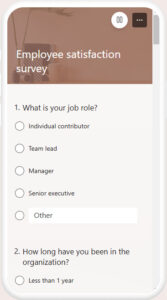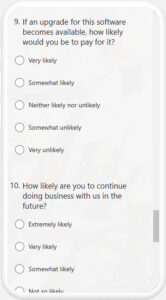How Feedback Loops Drive Growth and Innovation
In a recent episode of The CollabTalk Podcast, I talked about a fundamental yet often overlooked driver of business success—stakeholder engagement through scalable, repeatable feedback loops. What is a feedback loop?
feedback loop (noun)
A system, process, or mechanism in which the output or results of an action are returned as input, influencing future performance, decision-making, or adjustments. Feedback loops can be positive (reinforcing and amplifying change) or negative (regulating and stabilizing outcomes), and they are commonly used in business, technology, engineering, and biological systems to drive continuous improvement.
Example: A well-structured customer feedback loop helps companies refine their products based on user experiences and suggestions.
Whether you’re managing a team, running a business, or building partnerships, establishing structured feedback mechanisms is essential for clarity, trust, and continuous improvement. The episode was based on a session that I gave last fall at TechCon365 in Dallas and again at ESPC Stockholm. I’m continuing to expand on this content, and as mentioned toward the end of the podcast episode, I’m planning to develop workshops around this content to help organizations and individuals think more comprehensively about how they collect feedback, and how to get the most out of this data.
 Where Organizations Go Wrong with Feedback
Where Organizations Go Wrong with Feedback
While most companies acknowledge the importance of feedback, many struggle to implement it effectively. The biggest challenges arise not from a lack of intent but from flawed execution—processes that are inconsistent, overly complex, or disconnected from decision-making. Without a structured and transparent system, feedback often gets lost, ignored, or mismanaged, leading to disengaged employees, frustrated customers, and missed opportunities for innovation. Common pitfalls include treating feedback as a one-time event rather than an ongoing conversation, failing to close the loop with stakeholders, or siloing insights across different teams without alignment. Additionally, overburdening stakeholders with excessive feedback requests—without demonstrating meaningful action—can lead to fatigue and disengagement. By identifying and addressing these barriers, organizations can transform feedback from a reactive obligation into a proactive driver of growth, trust, and continuous improvement.
When feedback is embedded into daily operations, it fosters:
- Clarity & Alignment: Ensuring everyone is on the same page, from employees to customers.
- Stronger Relationships: Building trust by showing stakeholders that their input is valued.
- Motivation & Ownership: Engaging people by making them active contributors to improvements.
- Proactive Problem-Solving: Addressing issues before they escalate into crises.
- Continuous Improvement: Creating a culture where organizations evolve based on real insights.
Despite good intentions, many companies struggle to establish effective feedback mechanisms. Common pitfalls include:
- Lack of Clear Process: Feedback gets lost in scattered emails and unstructured meetings.
- Failure to Close the Loop: If stakeholders don’t see action taken, they stop providing input.
- Siloed Communication: Different teams collect feedback independently, leading to misalignment.
- Overcomplication: Long surveys and tedious processes discourage participation.
- Ignoring Stakeholder Input: Leaders resist feedback that challenges their agenda.
- Lack of Innovation Focus: Feedback isn’t just about fixing problems—it’s also about driving growth.
- Feedback Fatigue: Asking for input too often without acting on it results in disengagement.
Building Scalable Feedback Systems
Creating an effective feedback system isn’t just about gathering input—it’s about designing a structured, repeatable, and scalable process that integrates seamlessly into daily operations. Organizations that succeed in this area don’t rely on ad-hoc surveys or sporadic check-ins; they establish feedback mechanisms that continuously inform decision-making and innovation. The key is to choose the right tools and methods for different stakeholders, ensuring engagement without overwhelming employees, customers, or partners. Whether through real-time sentiment analysis, structured surveys, or interactive platforms, businesses that prioritize scalable feedback gain deeper insights, stronger engagement, and a proactive approach to problem-solving. The challenge lies in balancing automation with human touchpoints, maintaining actionability, and avoiding feedback fatigue.
To create a sustainable and effective feedback culture, organizations need structured, repeatable mechanisms that match their needs. Some of the best approaches include:
Employee Feedback
-
- Pulse Surveys – Quick, frequent check-ins to track sentiment in real-time.
- 360-Degree Feedback – Insights from peers, managers, and direct reports to improve performance.
- AI-Powered Chatbots – Collecting structured feedback at scale with minimal friction.
- Sentiment Analysis Tools – AI-driven insights from emails and chats to identify engagement trends.
Customer & Partner Feedback
-
- Net Promoter Score (NPS) Surveys – Simple, effective tracking of customer loyalty.
- Community Feedback Platforms – Engaging users in dedicated discussion forums.
- One-on-One Interviews & Focus Groups – Deep qualitative insights for major business decisions.
- Gamification & Interactive Feedback – Encouraging engagement through rewards and participation incentives.
Anonymous & Passive Feedback Collection
-
- Anonymous Portals – Providing safe spaces for honest, unfiltered input.
- AI Sentiment Analysis – Identifying early warning signs of dissatisfaction.
 Making Feedback Meaningful: Best Practices
Making Feedback Meaningful: Best Practices
Collecting feedback is only the first step—what truly matters is how organizations act on it. A meaningful feedback system fosters trust, transparency, and continuous engagement, ensuring that stakeholders feel heard and see tangible results from their input. The most successful companies create clear feedback channels, simplify participation, and communicate outcomes effectively. When stakeholders understand that their insights lead to real change, they become more engaged in the process, fueling a culture of innovation and collaboration. Additionally, automation and AI can enhance efficiency, but organizations must maintain a human-centered approach to interpreting and applying insights. By embedding feedback into the core of business strategy, companies can drive long-term growth and adaptability.
- Communicate the Purpose – Explain why feedback is collected and how it will be used.
- Make It Easy – Remove barriers that discourage participation.
- Be Transparent – Share findings and the actions taken as a result.
- Encourage Two-Way Dialogue – Feedback should spark discussion, not just data collection.
- Automate Where Possible – AI and automation help manage large-scale feedback effectively.
From Insight to Action: How Leadership Can Drive Change
For feedback to create meaningful business impact, leadership must be actively involved in both interpreting insights and driving action. Organizations that treat feedback as a passive reporting function miss a key opportunity to align strategic objectives with real-world stakeholder needs. Strong leadership fosters a culture where feedback isn’t just collected—it’s leveraged as a tool for decision-making, continuous improvement, and competitive advantage. The most forward-thinking companies integrate AI-driven feedback models, predictive analytics, and structured response strategies to not only react to issues but to anticipate and prevent them before they escalate. Leaders who embed feedback into their operational DNA create organizations that adapt quickly, innovate continuously, and maintain stronger relationships with employees, customers, and partners.
- Align Business Strategy with Feedback – Leaders must prioritize stakeholder insights in decision-making.
- Make Feedback a Cultural Norm – Strong organizations encourage open and continuous dialogue.
- Leverage AI & Automation – Tools like real-time sentiment analysis and predictive feedback models can proactively address challenges before they arise.
At its core, feedback isn’t just about fixing problems—it’s about creating opportunities. The most successful organizations don’t just listen to stakeholders; they act, iterate, and improve continuously. The key is to build systems that are scalable, actionable, and integrated into daily operations.
So, where can you introduce better feedback loops in your own work? How can you make feedback an integral part of decision-making? The businesses that listen and adapt will thrive, while those that ignore feedback risk stagnation.
To dive deeper into this topic, watch the full podcast episode below:

 Where Organizations Go Wrong with Feedback
Where Organizations Go Wrong with Feedback Making Feedback Meaningful: Best Practices
Making Feedback Meaningful: Best Practices


